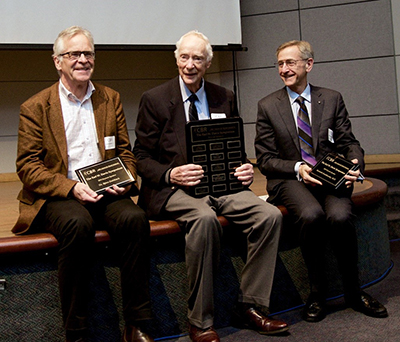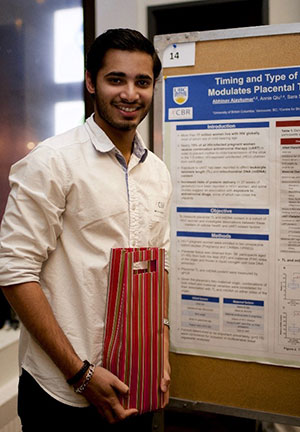![]() By KT Committee Journalist Team*
By KT Committee Journalist Team*
Dr. Earl W. Davie’s illustrious research career has spanned over four decades and revolutionized treatment options for hemophilia patients. Together with his colleagues, he characterized the ‘Waterfall Sequence’: the molecular cascades involved in the formation of the fibrin clot. To honor this distinguished investigator, the CBR hosts the annual Earl Davie Symposium, showcasing endeavors in the fields of vascular biology, hemostasis-thrombosis, cardiovascular and neurologic disease, by both local and international experts.
The 9th annual symposium was held at the SFU Harbour Centre downtown, which treated attendees to sweeping waterfront views of Vancouver. Keynote presenter Dr. Kenneth Kaushansky from Stony Brook University began the day’s proceedings with an engaging talk on thrombopoiesis. He discussed recent therapeutic advancements and discoveries in the field, including collaborations with his daughter on various projects. Dr. Gayatri Sreenivasan, the Medical Director of the VGH Apheresis Program, then highlighted the importance of the early diagnosis and treatment of thrombotic thrombocytopenic purpura (TTP). Once diagnosed, the mortality rates of patients with TTP can shift dramatically from 90% to under 10% using plasma exchange.
During her poignant talk, TTP-survivor Mina Rajan shared the emotional and physical challenges of life with TTP, crediting her recovery to the ongoing support of the Answering TTP foundation. Speaking with Mina after her talk, she remarked that she was overwhelmed by all of the interest and inspiration she received from the symposium attendees. She was taken aback by the passion and dedication of CBR researchers for their work, along with their earnest desire to improve the lives of patients like herself. The morning session concluded with short talks from Drs. Junmei Chen and Linda Sun, both who presented research which provided insight into von Willebrand Disease.
During the delicious lunch spread, we were fortunate to be able to sit down with Dr. Davie himself, together with Nobel Prize winner, Dr. Eddy Fischer. Both Earl and Eddy spoke candidly about their struggles and highlights during their careers. It was immediately apparent that their success could largely be attributed to their genuine zest for the scientific process, a deep curiosity about the unknown and a witty sense of humor. Eddy in particular had some sage advice for the next generation of scientists, encouraging them to ‘always be prepared for the unexpected’. He shared that from personal experience, many of his greatest scientific revelations had been completely serendipitous. Therefore, we are advised to keep an open mind and be prepared to pursue tangents that catch our interest. Earl also stressed the importance of working in a collaborative environment and embracing emerging technologies as alternatives to more traditional techniques. It was clear that neither Eddy nor Earl were showing any signs of settling down and remain very keen on staying connected with the vibrant scientific community.
The Poster Session featured the fascinating and diverse projects by CBR’s own students, postdoctoral fellows and researchers. The high-quality poster presentations were extremely well-received, serving as a platform for many engaging conversations. Out of all the sterling research posters presented the best poster prize was ultimately awarded to Abhinav Ajaykumar, a third-year PhD student in Dr. Hélène Côté’s lab. His poster, titled “Timing and type of maternal combinations anti-retroviral therapy modulates placental telomere length and mitochondrial DNA levels” highlights his research progress in unravelling how anti-HIV drugs affect cellular aging. Abhinav thanked the encouragement from his fellow lab members, as well as the organizers and volunteers of the symposium. In the future, Abhinav plans to use his PhD training as a platform to enter the public health industry.
The afternoon session commenced with a keynote talk by Dr. Bjorn Dahlback, on novel insights into the dual role of Factor V (FV) as both a coagulant and anti-coagulant. He detailed the fascinating activation mechanisms and synergistic interactions between FV and Protein C. Dr. Susan Smyth, from the University of Kentucky, presented her recent discoveries on the development and progression of atherosclerosis. Dr. Smyth showed compelling data that elucidates the role of the protein PPA2B in suppressing atherosclerotic inflammation.
This year, the symposium offered the opportunity for CBR affiliated members to present their research alongside the invited speakers. Stefanie Novakowski started things off detailing her impressive work which utilizes platelets as drug delivery vehicles. Dr. Peter Schubert educated the audience on advances in platelet storage technology. Representing Dr. Hongshen Ma’s research group, PhD candidate Aline Santoso also presented her findings. A student in the Department of Mechanical Engineering, Ms. Santoso explained how microfluidic technology can be used to sort and characterize red blood cells in a simple high throughput manner. While the selected members represented very different fields of research, all displayed new and improved ways of handling blood components.
In the final set of presentations, Dr. Douglas Cines from the University of Pennsylvania reported his work on the therapeutic delivery of plasminogen activators and the pathogenesis of heparin-induced thrombocytopenia. Dr. Braedon McDonald concluded the day’s proceedings with some stunning examples of technological advances in in vivo imaging and intravital microscopy techniques to study platelet activation and coagulation during infection. Dr. McDonald illustrated his exceptional work on elegantly mapping the interactions between neutrophil extracellular traps and pathogens, as well as the deposition of fibrin during systemic infections.
Director of the CBR, Dr. Ed Conway, expressed his gratitude towards the participation and contributions of presenters and the audience alike, especially for the stimulating discussions during the Q&A sessions. He was delighted for yet another hugely successful symposium, and for the attendance of the guest of honor, Dr. Earl Davie himself. Ed also acknowledged all the hard work put in behind the scenes in preparation for the event and the support from Associate CBR Director, Ed Pryzdial, as well as Hana Kim and Anna Sinova. Reflecting on the exciting breakthroughs in the field of blood research presented at the symposium, CBR members could not hide their enthusiasm for their projects and anticipation for next year’s symposium.
Next, check out a fun Q & A with Ed and Ed: Interview with the CBR Director Ed Conway and CBR Associate Director Ed Pryzdial.
*CBR KT Committee Journalist Team:
Erika Siren, PhD Candidate in Kizhakkedathu lab
Tara Fernandez, Postdoctoral Fellow in Conway lab
Rolinda Carter, PhD Candidate in Pryzdial lab
Victor Lei, Lab Manager in Conway lab
Jenny Huang, Lab Tech in Conway lab
Linnette Ocariza, Lab Tech in Conway lab




